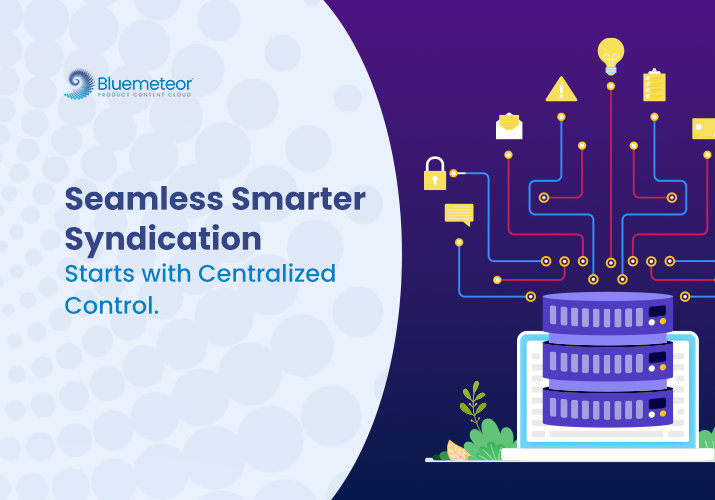Messy Product Data is Killing Your Product Data Sales: Here’s How to Fix it

This blog explains how messy data can derail your product data sales and gives you clear, actionable steps to tidy it up launching your PIM system. Plus, get an exclusive sneak peek at how Bluemeteor’s SKU Onboarding Portal is set to simplify your supplier collaboration.
Messy Data: The Hidden Threat to Your Product Data Sales
Messy data is like having a cluttered workspace — it slows you down and creates confusion. In the context of product data sales, messy data means incomplete, inconsistent, or duplicate information that customers see when they shop. When product details are mixed up, trust is lost, and sales take a hit.
What is Messy Data?
- Incomplete Information: Missing details about size, color, or features.
- Inconsistent Information: Conflicting product descriptions and specifications across channels.
- Duplicate Entries: The same product appears more than once, causing confusion.
By addressing these issues head-on, you’re not just cleaning up a mess—you’re protecting your product data sales and ensuring every customer sees accurate information.
How Messy Data Hurts Your Product Data Sales
Messy data can be more dangerous than it seems. It directly affects how customers interact with your brand and how search engines rank your pages.
Here’s a simple rundown of how messy data can sabotage your sales:
1. Customer Confusion and Loss of Trust
When your product info isn’t clear or consistent, customers get confused. If the description says one thing and the specs say another, buyers might wonder if they can trust you. Inconsistent data makes the whole buying process feel like a gamble.
“Clear and consistent product data is the backbone of customer trust. Without it, the buying journey becomes a maze.”
2. Missed Sales Opportunities
Incomplete or jumbled product details can lead to confusion, meaning buyers might not get all the information they need. Moreover, without clear details such as size, features, or pricing, customers are more likely to move on to a competitor who presents their data more transparently.
3. Inefficiency in Operations
Messy data isn’t just a problem for customers—it’s a headache for your team too. When employees spend time fixing errors or hunting for missing information, it slows down everything from inventory checks to order processing.
4. Poor Online Visibility and SEO Issues
Search engines love clean, well-organized data. When your product details are a mess, search engines can’t easily pick up on them, meaning your website might not show up as often in search results.
In other words, it leads to lower search rankings, meaning fewer visitors and, ultimately, fewer product data sales. If your data isn’t structured correctly, search engines might miss key details about your products.
“In the digital marketplace, clear data equals better visibility. And better visibility means more sales.”
Simple Steps to Clean Up Messy Data!
Streamline your data management process with easy steps to clean and organize messy product data. Ensure seamless data exchange and accuracy before committing to your product investments. Simplify your workflow with the right approach
Step 1: Conduct a Product Data Audit
Review your product information as if you’re decluttering a warehouse. Look for missing, inconsistent, or duplicate data across these key areas:
- Product Descriptions – Are they detailed, accurate, and SEO-friendly?
- Images & Media – Are they high-quality and correctly formatted?
- SKU Numbers – Are they unique and consistently structured?
- Pricing & Availability – Is everything up-to-date?
- Product Specifications – Are technical details standardized and complete?
Tip: Use a spreadsheet or data management tool to log issues and prioritize fixes.
A handy table can simplify this process:
| Data Field | Current State | What Needs Fixing |
| Product descriptions | Some are vague | Rewrite for clarity and consistency |
| Product images | Mixed quality | Standardize image sizes and resolutions |
| Pricing information | Outdated in some cases | Update pricing with current figures |
| SKU numbers | Some duplicates exist | Ensure every product has a unique SKU |
2. Standardize Your Data
Once you understand what’s wrong, the next step is to create a set of rules to standardize all product information. Specifically, this means setting clear guidelines for every piece of data, ensuring consistency and accuracy across the board.
To ensure data consistency, create clear rules for each product attribute.
- Descriptions – Include size, material, key features, and a benefits-driven approach.
- Image Guidelines – Set standard resolutions, backgrounds, and aspect ratios.
- SKU Naming Rules – Maintain a structured and scalable SKU format.
- Measurement Units – Keep all dimensions, weights, and technical specs uniform.
Quick Fix: Develop a product data style guide that all teams must follow!
For example, it’s important to require that every product description include key details such as size, material, and warranty information. In addition, consistency helps make your product listings look professional and trustworthy. Thus, customers are more likely to trust your brand and make a purchase, boosting your sales potential.y.
3. Automate Data Checks
Automation is your best friend when it comes to maintaining clean data. Set up automated checks that catch errors like missing fields or duplicate entries before they go live.
Eliminate manual errors by setting up automated checks in your system to detect:
- Duplicate SKUs
- Incomplete or empty fields
- Inconsistent pricing updates
- Formatting mistakes
Tools to Use: Data governance software, spreadsheet formulas, or PIM-based validation rules.
These tools, therefore, help ensure that every time a product is added or updated, it seamlessly meets your established standards.
4. Merge Duplicate Entries
Duplicates are like having the same document in two different folders—they create confusion and slow down processes.
Use software tools to find and merge duplicate entries so that each product appears only once, with all the correct details in one place.
Tip: Set a rule that prevents new products from being added unless they pass a duplicate check!
5. Keep Your Data Up-to-Date
Product data isn’t a “set-it-and-forget-it” task—it requires ongoing upkeep. Therefore, schedule regular audits and updates to keep your product data fresh and accurate.
Moreover, by routinely cleaning up your data, you’ll not only prevent future messes but also ensure that your product data sales continue to grow steadily.
Implement these maintenance habits:
- Quarterly Data Audits – Review and fix outdated or incorrect entries.
- Live Product Syncs – Ensure eCommerce and marketplace listings reflect real-time data.
- Supplier Data Checks – Validate new data before integration.
Why Clean Product Data Makes Your PIM System Even Better
Once your data is neat and tidy, you’re ready to bring in a PIM system, which works best when the data it manages is already in shape.
Here’s how clean data boosts your system’s performance:
1. More Accurate and Consistent Data
With clean data, your PIM system can effortlessly distribute the correct information across all platforms— whether it’s your website, third-party marketplaces, or even internal teams. Therefore, this consistency builds trust with your customers, improves their buying experience, and ultimately drives more sales.
2. Faster Product Launches
When your data is already organized, launching new products becomes faster and smoother. No more last-minute scrambling for missing details means you get to market quicker.
3. Better Customer Experience
Customers appreciate reliable and clear information. Thus, with clean data, your product pages become easier to understand, ultimately leading to more sales.
4. Easy Data Sharing
Clean, standardized data is simple to share. Whether you’re updating your website or listing products on multiple sites, having uniform data means everything stays on track.
Overcoming Common Data Challenges for Better Product Data Sales
Even with the best intentions, cleaning up data can still be challenging. However, understanding the obstacles can help you tackle them effectively.
Here are some common hurdles, and more importantly how to overcome them:
#1 Resistance to Change
Shifting from familiar, messy data practices to a standardized system can feel intimidating at first. However, you can make the transition smoother by starting small—focus on fixing one area at a time. As you make progress, be sure to celebrate each milestone.
After all, these early wins not only build momentum but also boost confidence, making it easier for your team to embrace new processes along the way.
#2 Limited Resources
Budget or time constraints can make data cleanup seem like a luxury. However, think of it as an investment. To start, prioritize areas where improvements will have the most significant impact on your product data sales. After all, even small changes can eventually lead to big gains over time.
#3 Technical Hurdles
The right technology can make a world of difference. Look for user-friendly tools that integrate well with your existing systems. If you need help, don’t hesitate to consult experts who can guide you through the transition.
The Future of Product Data: Unified Commerce and the Power of Clean Data
As we move toward an increasingly connected digital world, the quality of your product data becomes more critical. Unified commerce—where every sales channel works together seamlessly—relies on accurate, clean data. Here’s how this benefits your product data sales:
- Smooth Customer Journeys: Customers receive consistent, reliable information whether shopping online, in-store, or on mobile apps.
- Effortless System Integrations: Clean data makes it simple to connect new platforms or systems without a hitch.
- Deeper Insights: With accurate data, you can better understand customer behavior and adjust your strategy to maximize product data sales.
“Unified commerce is within reach for businesses that prioritize high-quality, clean data today.”
Introducing Bluemeteor’s SKU Onboarding Portal:
To help you further streamline your product data, Bluemeteor has introduced SKU Onboarding Portal. SKU Onboarding Portal is designed to connect your supplier data directly with your product information, ensuring that every piece of data is up-to-date and accurate.
Here’s how SKU Onboarding Portal can boost your product data sales:
- Seamless Data Integration: Automatically pull supplier data into your system so your product information stays current without extra effort.
- Consistent Data Quality: Say goodbye to manual errors. SKU Onboarding Portal ensures you have a single, reliable source of product information across all channels.
- Enhanced Collaboration: Create a unified platform that makes it easy for manufacturers, distributors, and suppliers to share and update product data efficiently.
- Works with Any PIM: SKU Onboarding Portal integrates effortlessly with your existing Product Information Management (PIM) system.
- Customizable Workflow Automation: Tailor workflows to fit your business needs and streamline your data management processes.
- Automated Validation and Quality Checks: With built-in AI-driven validation, SKU Onboarding Portal automatically flags inconsistencies, missing fields, or data errors — ensuring high-quality, clean product data across all channels.

SKU Onboarding Portal works hand-in-hand with your PIM system to ensure that your product data – from the moment it leaves the supplier to when it reaches the customer; is clean, accurate, and ready to drive sales.
Clean Data is the Key to Higher Sales
Messy data might seem like a minor nuisance, but it can seriously impact your product data sales.
Next Step? Once your data is clean, explore a PIM system that ensures ongoing accuracy, automation, and omnichannel consistency!
Ready to Increase Your Product Data Sales?
Take the first step towards streamlined operations and increased sales today. Reach out to Bluemeteor team, so you can discover how our innovative solutions—and specifically SKU Onboarding Portal—can help you effectively transform cluttered data into a powerful sales tool.
- Request a Demo: See firsthand how our PIM system and SKU Onboarding Portal work together to optimize your product data.
- Schedule a Consultation: Talk with our experts about the best ways to clean up your data and boost your product data sales.




